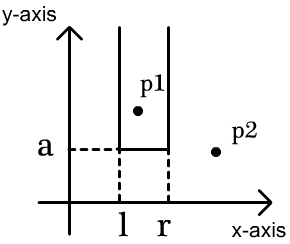CF1190D.Tokitsukaze and Strange Rectangle
普及/提高-
通过率:0%
AC君温馨提醒
该题目为【codeforces】题库的题目,您提交的代码将被提交至codeforces进行远程评测,并由ACGO抓取测评结果后进行展示。由于远程测评的测评机由其他平台提供,我们无法保证该服务的稳定性,若提交后无反应,请等待一段时间后再进行重试。
题目描述
There are n points on the plane, the i -th of which is at (xi,yi) . Tokitsukaze wants to draw a strange rectangular area and pick all the points in the area.
The strange area is enclosed by three lines, x=l , y=a and x=r , as its left side, its bottom side and its right side respectively, where l , r and a can be any real numbers satisfying that l<r . The upper side of the area is boundless, which you can regard as a line parallel to the x -axis at infinity. The following figure shows a strange rectangular area.
 A point (xi,yi) is in the strange rectangular area if and only if l<xi<r and yi>a . For example, in the above figure, p1 is in the area while p2 is not.
A point (xi,yi) is in the strange rectangular area if and only if l<xi<r and yi>a . For example, in the above figure, p1 is in the area while p2 is not.
Tokitsukaze wants to know how many different non-empty sets she can obtain by picking all the points in a strange rectangular area, where we think two sets are different if there exists at least one point in one set of them but not in the other.
输入格式
The first line contains a single integer n ( 1≤n≤2×105 ) — the number of points on the plane.
The i -th of the next n lines contains two integers xi , yi ( 1≤xi,yi≤109 ) — the coordinates of the i -th point.
All points are distinct.
输出格式
Print a single integer — the number of different non-empty sets of points she can obtain.
输入输出样例
输入#1
3 1 1 1 2 1 3
输出#1
3
输入#2
3 1 1 2 1 3 1
输出#2
6
输入#3
4 2 1 2 2 3 1 3 2
输出#3
6
说明/提示
For the first example, there is exactly one set having k points for k=1,2,3 , so the total number is 3 .
For the second example, the numbers of sets having k points for k=1,2,3 are 3 , 2 , 1 respectively, and their sum is 6 .
For the third example, as the following figure shows, there are
- 2 sets having one point;
- 3 sets having two points;
- 1 set having four points.
Therefore, the number of different non-empty sets in this example is 2+3+0+1=6 .
